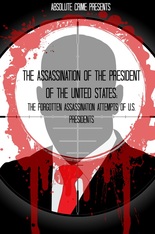The Assassination of the President of the United States: The Forgotten Assassination Attempts of U.S. Presidents

Everyone knows about the assassination of Lincoln and Kennedy—but did you know several attempts have been made on Barrack Obama? Or George Bush? Nearly every President has almost been killed at the hands of an Assassin.
This book chronicles every known attempt on a President's life and explains how the plot was ultimately foiled.
This book chronicles every known attempt on a President's life and explains how the plot was ultimately foiled.
Buy Now!
The Assassination of the President of the U.S. PDF and ePub |
Excerpt
Introduction
The President of the United States is the most powerful political figure in the nation. For just about every president, that power comes with danger as there are sure to be people who disagree with a president’s policies so much that they want him dead. There are also people who view the president as a symbol of the government as a whole and believe that killing him will make a broad statement. Of course, there are also people who are simply mentally disturbed and can think of no better way to draw attention to themselves than to assassinate the president.
There have been four presidents who have died due to assassination: Abraham Lincoln, James A. Garfield, William McKinley, and John F. Kennedy. Lincoln and Kennedy escaped assassination attempts before ultimately dying from gunshot wounds, but several presidents survived assassination plots. Remarkably, only two of those presidents – Theodore Roosevelt and Ronald Reagan – were harmed. The reasons for the attempts and why those attempts failed vary, but they all brought the nation dangerously close to tragedy.
Andrew Jackson
Andrew Jackson was known to say that he lived every day prepared to die. The end for the nation’s seventh president nearly came on January 30, 1835. Jackson was 67 at the time and not a well man. Many wondered if he would live to complete his term. Adding to his difficulties was the conflict between his Democratic party and the Whigs over the fate of the Bank of the United States. Just two years earlier, in what many called an abuse of his executive powers, Jackson withdrew federal funds from the Second Bank of the United States and redistributed it to state banks. By 1836, the bank would lose its charter and close.
South Carolina Congressman Warren R. Davis was well liked among his colleagues, who were saddened to hear of the 41 year-old attorney’s death on January 29th. The members of the House, who honored Davis by wearing black armbands for 30 days, agreed that they would attend his funeral service in the House chamber of the Capitol building at noon the following day. Also in attendance was President Jackson.
When the funeral ended and Jackson left the Capitol, he leaned on his cane, appearing for all the world like a frail old man. An unemployed house painter named Richard Lawrence was waiting for the president. Lawrence approached Jackson, pointed a revolver at him, and fired. Perhaps due to the wet weather’s effect on the gunpowder, the gun misfired and the bullet did not discharge. This gave Jackson an opportunity to run for cover, although he didn't take it. Old Hickory, as Jackson was known, was enraged that Lawrence tried to shoot him and moved in closer to him. Lawrence pulled out a second revolver, closer to Jackson this time, and took aim. He pulled the trigger and miraculously, the second gun misfired, too.
With that, Jackson let loose on Lawrence with his cane until his aides pulled him away. Bystanders, including Tennessee Representative Davy Crockett, wrestled Lawrence to the ground. No doubt part of Jackson’s fury was his belief that Lawrence had been sent by Jackson’s political rivals. However, there is nothing to suggest that Lawrence had anything to do with the Whigs. He was angry that he was unemployed and blamed the sagging economy on the president. He was also mentally unstable. Lawrence not only accused Jackson of conspiring to keep him out of work but he claimed to be the heir to King Richard III, who died four hundred years earlier.
Lawrence was tried and after just a few minutes of deliberation, was found not guilty by reason of insanity. He lived the rest of his in insane asylums. Vice-president Martin Van Buren, still not sure that the Whigs were not behind the incident, took to wearing guns whenever he visited the Senate.
The Smithsonian Institute conducted an experiment on both of Lawrence’s derringers in the 1930s. Researchers fired both guns and they fired correctly on the first try. The estimated odds of both guns misfiring are one in 125,000.
The President of the United States is the most powerful political figure in the nation. For just about every president, that power comes with danger as there are sure to be people who disagree with a president’s policies so much that they want him dead. There are also people who view the president as a symbol of the government as a whole and believe that killing him will make a broad statement. Of course, there are also people who are simply mentally disturbed and can think of no better way to draw attention to themselves than to assassinate the president.
There have been four presidents who have died due to assassination: Abraham Lincoln, James A. Garfield, William McKinley, and John F. Kennedy. Lincoln and Kennedy escaped assassination attempts before ultimately dying from gunshot wounds, but several presidents survived assassination plots. Remarkably, only two of those presidents – Theodore Roosevelt and Ronald Reagan – were harmed. The reasons for the attempts and why those attempts failed vary, but they all brought the nation dangerously close to tragedy.
Andrew Jackson
Andrew Jackson was known to say that he lived every day prepared to die. The end for the nation’s seventh president nearly came on January 30, 1835. Jackson was 67 at the time and not a well man. Many wondered if he would live to complete his term. Adding to his difficulties was the conflict between his Democratic party and the Whigs over the fate of the Bank of the United States. Just two years earlier, in what many called an abuse of his executive powers, Jackson withdrew federal funds from the Second Bank of the United States and redistributed it to state banks. By 1836, the bank would lose its charter and close.
South Carolina Congressman Warren R. Davis was well liked among his colleagues, who were saddened to hear of the 41 year-old attorney’s death on January 29th. The members of the House, who honored Davis by wearing black armbands for 30 days, agreed that they would attend his funeral service in the House chamber of the Capitol building at noon the following day. Also in attendance was President Jackson.
When the funeral ended and Jackson left the Capitol, he leaned on his cane, appearing for all the world like a frail old man. An unemployed house painter named Richard Lawrence was waiting for the president. Lawrence approached Jackson, pointed a revolver at him, and fired. Perhaps due to the wet weather’s effect on the gunpowder, the gun misfired and the bullet did not discharge. This gave Jackson an opportunity to run for cover, although he didn't take it. Old Hickory, as Jackson was known, was enraged that Lawrence tried to shoot him and moved in closer to him. Lawrence pulled out a second revolver, closer to Jackson this time, and took aim. He pulled the trigger and miraculously, the second gun misfired, too.
With that, Jackson let loose on Lawrence with his cane until his aides pulled him away. Bystanders, including Tennessee Representative Davy Crockett, wrestled Lawrence to the ground. No doubt part of Jackson’s fury was his belief that Lawrence had been sent by Jackson’s political rivals. However, there is nothing to suggest that Lawrence had anything to do with the Whigs. He was angry that he was unemployed and blamed the sagging economy on the president. He was also mentally unstable. Lawrence not only accused Jackson of conspiring to keep him out of work but he claimed to be the heir to King Richard III, who died four hundred years earlier.
Lawrence was tried and after just a few minutes of deliberation, was found not guilty by reason of insanity. He lived the rest of his in insane asylums. Vice-president Martin Van Buren, still not sure that the Whigs were not behind the incident, took to wearing guns whenever he visited the Senate.
The Smithsonian Institute conducted an experiment on both of Lawrence’s derringers in the 1930s. Researchers fired both guns and they fired correctly on the first try. The estimated odds of both guns misfiring are one in 125,000.








